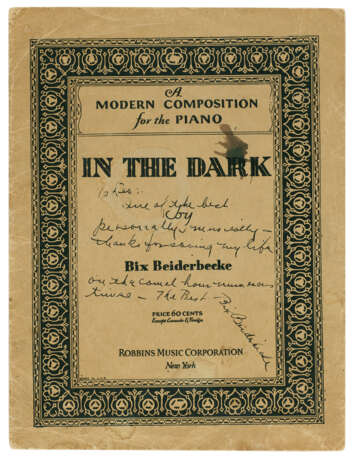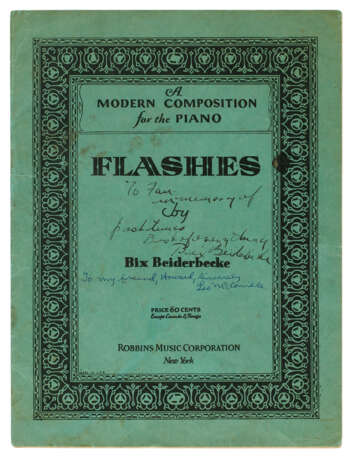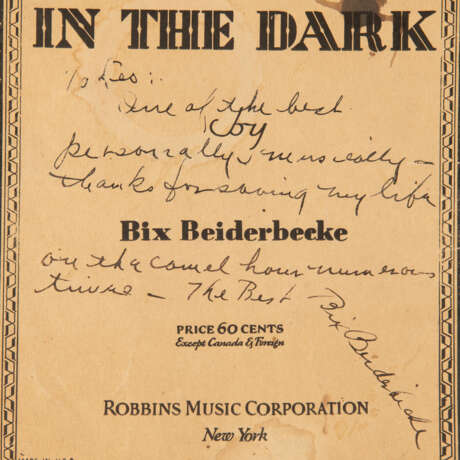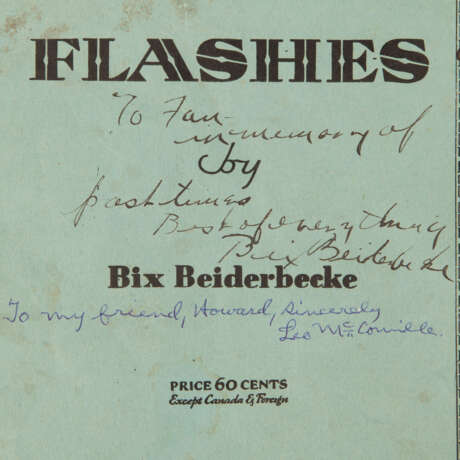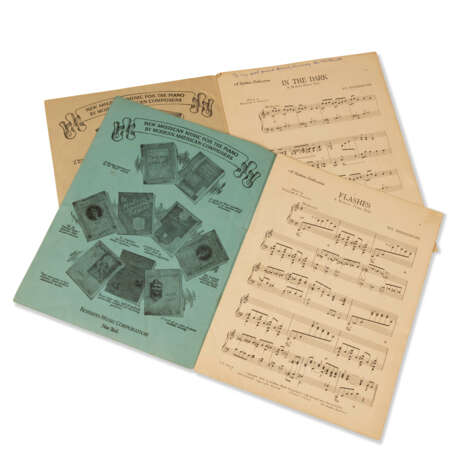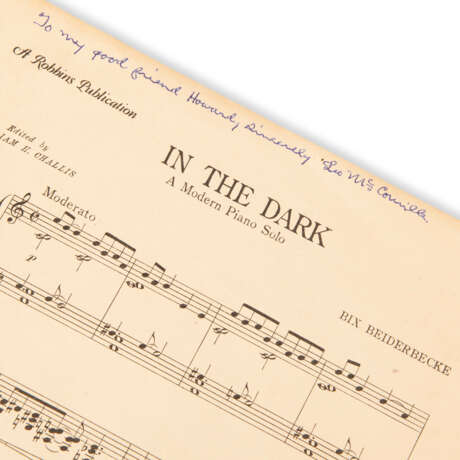ID 1016460
Lot 141 | Flashes and In the Dark
Estimate value
£ 6 000 – 10 000
Leon Bismark “Bix” Beiderbecke
BEIDERBECKE, Leon Bismark “Bix” (1903-1931). Flashes and In the Dark. New York: Robbins Music Corporation, 1931.
First editions of the printed piano scores, each signed and inscribed by Bix Beiderbecke. Flashes inscribed in black ink on the front cover ‘To Fan, in memory of past times, Best of everything, Bix Beiderbecke,’ and In the Dark inscribed ‘To Leo: One of the best personally & musically – thanks for saving my life on the camel hour numerous times – The Best, Bix Beiderbecke,’ each subsequently inscribed by trumpeter Leo McConville to historian Howard M. James, together with the piano score for In a Mist, 1928.
A gifted cornetist, pianist and composer, Bix Beiderbecke’s professional career spanned only seven years and some 250 recordings until chronic alcoholism contributed to his death at the age of 28, giving rise to the original romantic legend of the jazz genius and a scholarly mythology that persists to this day, with many citing him as a profound influence on his contemporaries and an important innovator in early jazz. Beiderbecke’s meteoric rise and early death have ensured that very few manuscript traces have remained. He published only five piano compositions in his lifetime, of which three are represented here, and two with rare inscriptions. We know of only two other examples inscribed to musical colleagues: one to cornetist Bill Priestly, the other to Hoagy Carmichael, the latter of which is held at the Lilly Library, Indiana University.
The recipient of the present inscribed scores was trumpeter Leo McConville, described by Sudhalter & Evans as ‘a New York studio musician who… himself developed a jazz style along markedly Bix-influenced lines,’ and who sat next to Bix in the Camel Band from June 1930. After being cut loose from Paul Whiteman’s orchestra, playing in the band for weekly NBC radio show the Camel Pleasure Hour was the last serious gig that Bix, with McConville’s support, was able to hold down for any length of time. In Bix: The Leon Bix Beiderbecke Story, Evans & Evans write: ‘[By September 1930] Bix was becoming less dependable on the radio program. Where he previously had detested rehearsals, he now would shun them altogether… These missed rehearsals resulted in Bix being unfamiliar with the tunes to be played on each program. Art Schutt stated they never knew if Bix was going to play the 8 bars assigned to him, or 80 bars, or even 4 bars… Not knowing quite how to cope with it, Bix asked for Leo's help. This resulted in Leo kicking Bix in the shins to play, another kick to stop, and another to play,’ and so it continued until 8 October 1930, when ‘Bix blacked out in the middle of a solo’. Despite a short trip home to Davenport, Bix failed to fully recover from this final breakdown. Thereafter, Bix worked with arranger Bill Challis transcribing these piano pieces for publication by the Robbins Music Corporation. Evans & Evans cite Challis: ‘Flashes, Bix did it in a hurry. He wasn’t working and he did the composition because he needed the money. Jack Robbins was willing to accept almost anything… It was the only income he had going.’ McConville remembered Bix inscribing these scores for him around May 1931, the month following their publication, and just three months before his untimely death. Evans & Evans, 510, 524, 534, 538, 552. Sudhalter & Evans, 306.
Three printed piano scores, quarto (312 x 237 mm). Loose in the original wraps as issued (some rubbing, soiling and waterstaining, In The Dark with small chips to lower edge). Housed in a modern custom quarter morocco solander box. Provenance: Leo McConville (trumpeter, Camel Hour Orchestra) – Howard M. James (jazz historian and biographer). Illustrated: Evans & Evans, 535, 536.
| Address of auction |
CHRISTIE'S 8 King Street, St. James's SW1Y 6QT London United Kingdom | |
|---|---|---|
| Preview |
| |
| Phone | +44 (0)20 7839 9060 | |
| Buyer Premium | see on Website | |
| Conditions of purchase | Conditions of purchase |
